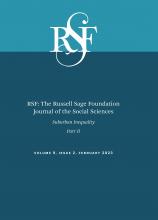Research Article
Open Access
Demographic Change and School Attendance Zone Boundary Changes: Montgomery County, Maryland, and Fairfax County, Virginia, Between 1990 and 2010
Erica Frankenberg, Christopher S. Fowler, Sarah Asson, Ruth Krebs Buck
RSF: The Russell Sage Foundation Journal of the Social Sciences February 2023, 9 (2) 75-103; DOI: https://doi.org/10.7758/RSF.2023.9.2.04
Erica Frankenberg
aProfessor of education and demography at Pennsylvania State University, United States
Christopher S. Fowler
bAssociate professor of geography and demography at Pennsylvania State University, United States
Sarah Asson
cPhD candidate in educational leadership at Pennsylvania State University, United States
Ruth Krebs Buck
dPhD student in geography at Pennsylvania State University, United States

REFERENCES
- ↵
- Allard, Scott W., and
- Elizabeth Pelletier
- ↵
- Asson, Sarah,
- Erica Frankenberg,
- Annie Maselli,
- Ian Burfoot-Rochford,
- Christopher S. Fowler, and
- Ruth Krebs Buck
- ↵
- Ayscue, Jennifer B., and
- Gary Orfield
- ↵
- Barnum, Matt
- ↵
- Bathia, Shruti,
- Bruce Fuller,
- Claudia Galindo,
- Francisco Lagos, and
- Sophia Rabe-Hesketh
- ↵
- Bischoff, Kendra
- ↵
- Borman, Geoffrey D., and
- Maritza Dowling
- ↵
- Chen, Xinchun,
- Yukiko Furuya,
- Alex Harwin, and
- Be Herold
- ↵
- Creswell, John W
- ↵
- ↵
- Diamond, John B., and
- Linn Posey-Maddox
- ↵
- Diem, Sarah,
- Anjalé D. Welton,
- Erica Frankenberg, and
- Jennifer Jellison Holme
- ↵
- Eaton, Susan
- ↵
- Eaton, Susan
- ↵
- Elbers, Benjamin
- ↵
- Ellen, Ingrid Gould
- ↵
- Erickson, Ansley T
- ↵
- Fairfax County Public Schools
- ↵
- Fairfax County Public Schools
- ↵
- Fairfax County Public Schools
- ↵
- Farrell, Chad R
- ↵
- Fiel, Jeremy
- ↵
- Fiel, Jeremy
- ↵
- Fowler, Christopher S
- ↵
- Fowler, Christopher S.,
- Barrett A. Lee, and
- Stephen A. Matthews
- ↵
- Fowler, Christopher S.,
- Danielle C. Rhubart, and
- Leif Jensen
- ↵
- Frankenberg, Erica
- ↵
- Frankenberg, Erica,
- Jongyeon Ee,
- Jennifer B. Ayscue, and
- Gary Orfield
- ↵
- ↵
- Frankenberg, Erica, and
- Gary Orfield
- ↵
- Frey, William H
- ↵
- Girouard, Jennifer
- ↵
- Goldsmith, Pat Rubio
- ↵
- Goldstein, Dana
- ↵
- Grooms, Ain
- ↵
- Hall, Matthew
- ↵
- Hanushek, Eric A.,
- John F. Kain, and
- Steven G. Rivkin
- ↵
- Hasan, Sharique, and
- Anuj Kumar
- ↵
- Holme, Jennifer J
- ↵
- Holme, Jennifer J.,
- Sarah Diem, and
- Anjalé Welton
- ↵
- ↵
- Johnson, Rucker C
- ↵
- Lareau, Annette, and
- Kimberly Goyette
- ↵
- Lewis, Amanda, and
- John Diamond
- ↵
- Lewis-McCoy, R. L’Heureux
- ↵
- Lichter, Daniel T
- ↵
- ↵
- ↵
- Lichter, Daniel T.,
- Brian C. Thiede, and
- Matthew M. Brooks
- ↵
- Lung-Amam, Willow
- ↵
- Lyons, Jane
- ↵
- Manson, Steven,
- Jonathan Schroeder,
- David Van Riper,
- Tracy Kugler, and
- Steven Ruggles
- ↵
- Martin, Michael J. R., and
- Christopher S. Fowler
- ↵
- Mattingly, Justin
- ↵
- McArdle, Nancy, and
- Dolores Acevedo-Garcia
- ↵
- McDermott, Kathryn A.,
- Erica Frankenberg,
- Elizabeth DeBray,
- Anna Fung-Morley,
- Tiffanie Lewis,
- Julie Spencer-Robinson, and
- Maylene Rodriquez Scott
- ↵
- Mickelson, Roslyn, and
- Mokubung Nkomo
- ↵
- Monarrez, Tomas
- ↵
- Montgomery County Public Schools
- ↵
- Morgan, David R., and
- Robert E. England
- ↵
- Murphy, Alexandra K., and
- Scott W. Allard
- ↵
- National Center for Education Statistics
- ↵
- National Center for Education Statistics
- ↵
- Orfield, Gary
- ↵
- Orfield, Gary
- ↵
- Orfield, Gary, and
- Erica Frankenberg
- ↵
- Orfield, Myron
- ↵
- Owens, Ann, and
- Peter Rich
- ↵
- Parcel, Toby L., and
- Andrew J. Taylor
- ↵
- Parisi, Domenico,
- Daniel T. Lichter, and
- Michael C. Taquino
- ↵
- Peetz, Caitlynn
- ↵
- Peetz, Caitlynn
- ↵
- Peetz, Caitlynn
- ↵
- Pettigrew, Thomas F., and
- Lina R. Tropp
- ↵
- Phelps, Nicholas A
- ↵
- Reardon, Sean F.,
- Ericka S. Weathers,
- Erin M. Fahle,
- Heewon Jang, and
- Demetra Kalogrides
- ↵
- Reed, Dan
- ↵
- ↵
- Rodgers, Bethany
- ↵
- Saporito, Salvatore
- ↵
- Saporito, Salvatore, and
- Deenesh Sohoni
- ↵
- Schwartz, Heather
- ↵
- ↵
- Siegel-Hawley, Genevieve,
- Kimberly Bridges, and
- Thomas J. Shields
- ↵
- Siegel-Hawley, Genevieve,
- Sarah Diem, and
- Erica Frankenberg
- ↵
- Stearns, Elizabeth
- ↵
- Taylor, Kendra, and
- Erica Frankenberg
- ↵
- Vigdor, Jacob L., and
- Jens Ludwig
- ↵
- Wiley, Kathryn,
- Barbara Shircliffe, and
- Jennifer Morley
- ↵
- Woolsey, Angela
- ↵
- WXY Architecture + Urban Design
- ↵
- Zhang, Charlie H., and
- Matt Ruther
In this issue
Demographic Change and School Attendance Zone Boundary Changes: Montgomery County, Maryland, and Fairfax County, Virginia, Between 1990 and 2010
Erica Frankenberg, Christopher S. Fowler, Sarah Asson, Ruth Krebs Buck
RSF: The Russell Sage Foundation Journal of the Social Sciences Feb 2023, 9 (2) 75-103; DOI: 10.7758/RSF.2023.9.2.04
Demographic Change and School Attendance Zone Boundary Changes: Montgomery County, Maryland, and Fairfax County, Virginia, Between 1990 and 2010
Erica Frankenberg, Christopher S. Fowler, Sarah Asson, Ruth Krebs Buck
RSF: The Russell Sage Foundation Journal of the Social Sciences Feb 2023, 9 (2) 75-103; DOI: 10.7758/RSF.2023.9.2.04
Jump to section
Related Articles
- No related articles found.
Cited By...
- No citing articles found.





